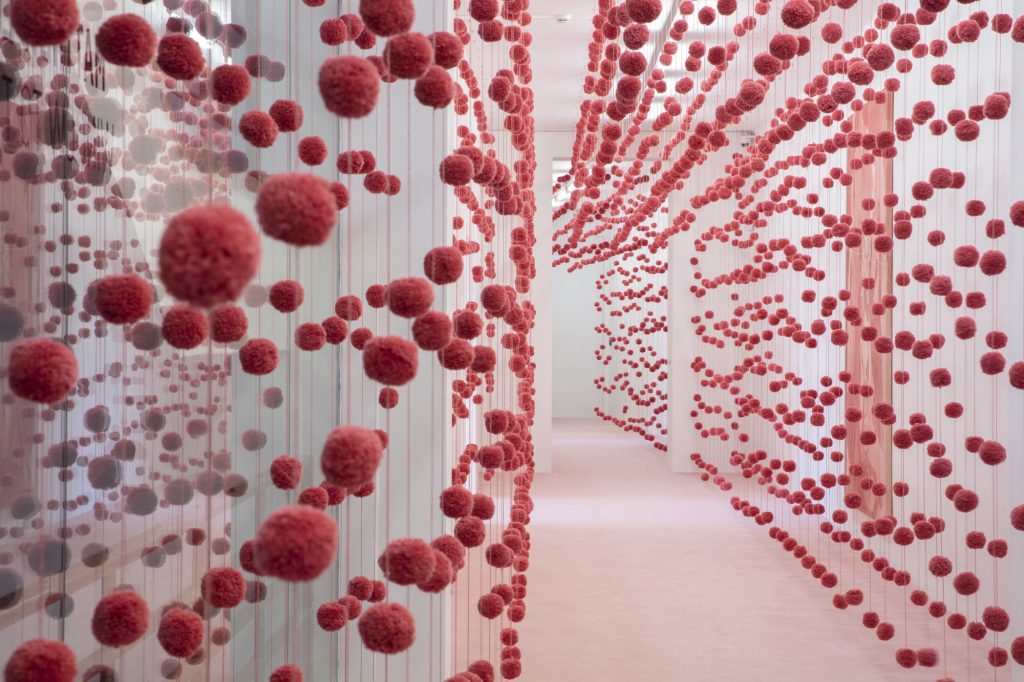Matthew Lutz-Kinoy: Window to the Clouds
Salon Berlin presents Window to the Clouds, an exhibition by Matthew Lutz-Kinoy. The exhibition is formulated as an immersive and sensorial environment in which viewers may experience the diverse range of Lutz-Kinoy’s practice.
Salon Berlin presents Window to the Clouds, an exhibition by Matthew Lutz-Kinoy. The exhibition marks the first institutional solo show in Germany by the Paris-based artist, and is formulated as an immersive and sensorial environment in which viewers may experience the diverse range of Lutz-Kinoy’s practice. The exhibition is characterised by a sense of lushness and layered warmth; an invitation to experience an otherworldly interpretation of the quotidien. There is a strong sense of fluid intuition and tactility encompassed within each of these works. Comprised of recent paintings, ceramics splashed with colourful glaze and abstract forms, and a site-specific sculpture, the exhibition imagines a series of contemporary landscapes as painterly reflections that look at — and through — various architectures, historical paintings, and current events. These environments act as stages for worlds of shared experience, human presence, and touch.
Patricia Kamp, founder and artistic director of the Salon Berlin, explains, “Experience lies at the heart of Matthew Lutz-Kinoy’s artistic practice. By employing the entire materiality of the works, he engages with visitors’ multiple senses, inviting them to deeply engage with the space, both physically and intellectually. At a time when we eagerly miss shared moments and interactions, Window to The Clouds unfolds as an experiential, sensorial expanse in which we are immersed – nurturing, liberating, hopeful, like clouds in the sky.”
Lutz-Kinoy approaches painting in a spatial manner. There are few straight lines within any of his works; each piece holds elements of fluidity, texture, and organic movement. These forms are juxtaposed and bound with the sharp geometry of a frame, containing the warm presence of the works. Drawing upon Lutz-Kinoy’s focus on the body and performance, visitors enter the space via an immersive sculpture of pink pompoms and a soft pink carpet. Paintings are arranged within this installation, requiring the viewer to be enveloped within this other world. The repetitive and playful softness is contrasted with these paintings, in which bodies, sacred and profane, appear. In Exhausted Angel Receives an Announcement in Rodin’s Garden (2019), Lutz-Kinoy depicts a cherub, rendered in the color of a blush, gazing upwards. Two shadowy arms reach down toward the weary figure from outside the composition’s edge. The garden scene, framed by a bushy rococo evergreen, is a painterly contemplation upon the porousness between interior and exterior environments. Like a window, a painting can invite a viewer beyond the present. In dialogue with Wings of Flamingos, Camargue (2020) — a large, site-specific ceiling painting in an adjacent gallery that calls to the figure of the exhausted angel — the lush floor covering directs attention to the theatrical possibilities of architecture, and to the activation of a room through ornamentation. Matthew Lutz-Kinoy echoes this thematic generosity in his painting technique, which evokes printmaking. The artist’s additive application of acrylics, his gestural brushwork, and his overlapping, translucent colors offer an exploration of depth, both pictorial and spiritual.
In other paintings, Lutz-Kinoy removes details from their surroundings in order to resituate them and to look at them anew, such as in Lectures of Burle Marx (2020), a portrait of a wild orchid found on a Rio de Janeiro sidewalk. As with the flower-like forms of the pompoms, plants and flowers are often protagonists in Lutz-Kinoy’s work, appearing as companions to or extensions of the body. In each of these paintings, the frame is an active space where relationships can be recalibrated, transience articulated, and a field defined for the viewer to be absorbed in.
Turning seasons and fleeting clouds convey change and the passage of time. For Lutz-Kinoy, time is neither a linear nor singular concept. “Futurity can be a problem,” wrote the performance theorist José Esteban Muñoz in the influential book Cruising Utopia (2009), from which Lutz-Kinoy draws. In his argument, Muñoz critiques “straight time,” his term for conventional investments in the future. Time is straight, it follows, when the future is foreclosed on by the present. Heteronormativity is not, therefore, just a sexual relation, but is a mode of social production. Yet rather than contending that there is consequently — or even radically — no future, Muñoz celebrates the existence of many potential futures in the present. Futures are created on the dance floor, the stage, and elsewhere that queer worlds are enacted. In these places, a re-vision of the future is seen through the window of queered performativity.
Within Window to the Clouds, visitors are guided and surrounded through intimate interventions and explorations of spaces beyond hereditary or inherited time. The works each contain a sense of presence that is at once gentle and tactile, but not overwhelming. These abstractions form an invitation to experience, as Muñoz names it, ecstasy on earth.
Window to the Clouds is on show at Salon Berlin until July 3, 2021.
Salon Berlin is the Berlin-based project and exhibition space of the renowned Museum Frieder Burda, Baden-Baden.

















